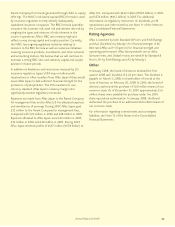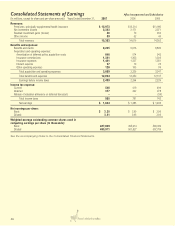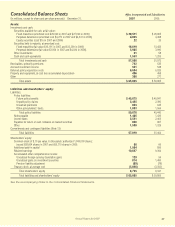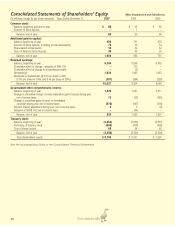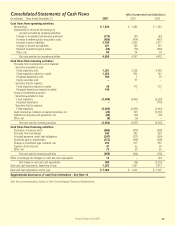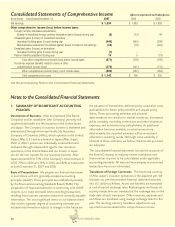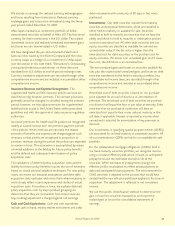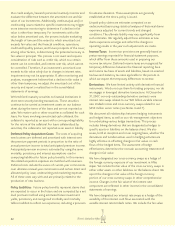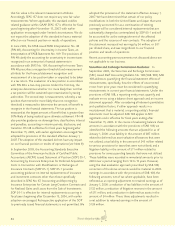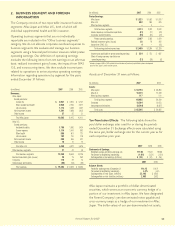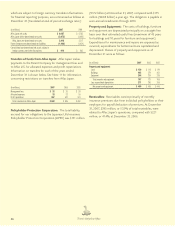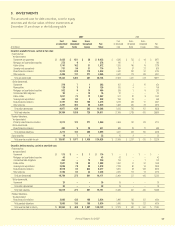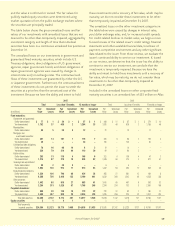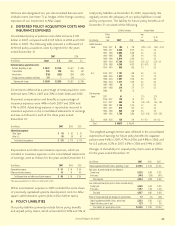Aflac 2007 Annual Report Download - page 57
Download and view the complete annual report
Please find page 57 of the 2007 Aflac annual report below. You can navigate through the pages in the report by either clicking on the pages listed below, or by using the keyword search tool below to find specific information within the annual report.
53
Annual Report for 2007
of the interest rate swaps in either other assets or other
liabilities on the balance sheet. We report the changes in fair
value of the interest rate swaps in other comprehensive
income as long as they are deemed effective. Should any
portion of the swap be deemed ineffective, that value would
be reported in other income in the consolidated statements of
earnings.
Policyholder Protection Corporation and State Guaranty
Association Assessments: In Japan, the government has
required the insurance industry to contribute to a policyholder
protection corporation. We recognize a charge for our
estimated share of the industry’s obligation once it is
determinable. We review the estimated liability for
policyholder protection corporation contributions on an
annual basis and report any adjustments in Aflac Japan’s
expenses.
In the United States, each state has a guaranty association that
supports insolvent insurers operating in those states. To date,
our state guaranty association assessments have not been
material.
Treasury Stock: Treasury stock is reflected as a reduction of
shareholders’ equity at cost. We use the weighted-average
purchase cost to determine the cost of treasury stock that is
reissued. We include any gains and losses in additional paid-in
capital when treasury stock is reissued.
Earnings Per Share: We compute basic earnings per share
(EPS) by dividing net earnings by the weighted-average
number of unrestricted shares outstanding for the period.
Diluted EPS is computed by dividing net earnings by the
weighted-average number of shares outstanding for the
period plus the shares representing the dilutive effect of
share-based awards.
New Accounting Pronouncements: In December 2007, the
FASB issued Statement of Financial Accounting Standards
(SFAS) No. 160, Noncontrolling Interests in Consolidated
Financial Statements - an amendment of ARB No. 51 (SFAS
160). The purpose of SFAS 160 is to improve relevance,
comparability, and transparency of the financial information in
consolidated financial statements of reporting entities that
hold noncontrolling interests in one or more subsidiaries. SFAS
160 is effective for fiscal years beginning on or after
December 15, 2008, with earlier adoption prohibited. We do
not expect the adoption of this standard to have any effect on
our financial position or results of operations.
In February 2007, the FASB issued SFAS No. 159, The Fair
Value Option for Financial Assets and Financial Liabilities –
including an amendment of FASB Statement No. 115 (SFAS
159). SFAS 159 allows entities to choose to measure many
financial instruments and certain other items at fair value. The
majority of the provisions of this standard apply only to
entities that elect the fair value option (FVO). The FVO may
be applied to eligible items on an instrument-by-instrument
basis; is irrevocable unless a new election date occurs; and may
only be applied to an entire financial instrument, and not
portions thereof. This standard requires a business enterprise
to report unrealized gains and losses on items for which the
FVO has been elected in earnings at each subsequent
reporting date. SFAS 159 is effective for fiscal years beginning
after November 15, 2007, with earlier application permitted
under limited circumstances. We do not expect the adoption
of this standard to have a material effect on our financial
position or results of operations.
In September 2006, the FASB issued SFAS No. 158, Employers’
Accounting for Defined Benefit Pension and Other
Postretirement Plans, an amendment of FASB Statements No.
87, 88, 106, and 132(R) (SFAS 158). We adopted the
recognition and measurement date provisions of this standard
effective December 31, 2006. In the consolidated statements
of shareholders’ equity for the year ended December 31,
2006, we included in 2006 other comprehensive income, a
cumulative transition adjustment, net of income taxes, of $44
million from the adoption of SFAS 158. This cumulative effect
adjustment was properly included in the rollforward of
accumulated other comprehensive income for the year, but it
should not have been included in other comprehensive
income for the year. Total comprehensive income for the year,
not including the transition adjustment for SFAS 158, was
$996 million. Management concluded that the transition
adjustment was not material to the financial statements taken
as a whole. We have adjusted other comprehensive income
for the year ended December 31, 2006, to properly reflect the
transition adjustment as a direct charge to accumulated other
comprehensive income. The effect of recording the transition
adjustment through other comprehensive income and the
subsequent adjustment to reflect the amounts as a direct
charge to accumulated other comprehensive income did not
have any impact on the consolidated statements of earnings,
the consolidated balance sheets, the consolidated statements
of shareholders’ equity or the consolidated statements of cash
flows for any periods presented.
In September 2006, the FASB issued SFAS No. 157, Fair Value
Measurements (SFAS 157). SFAS 157 defines fair value,
establishes a framework for measuring fair value under GAAP,
and expands disclosures about fair value measurements. This
standard applies to other accounting pronouncements that
require or permit fair value measurements, the FASB having
previously concluded in those accounting pronouncements




